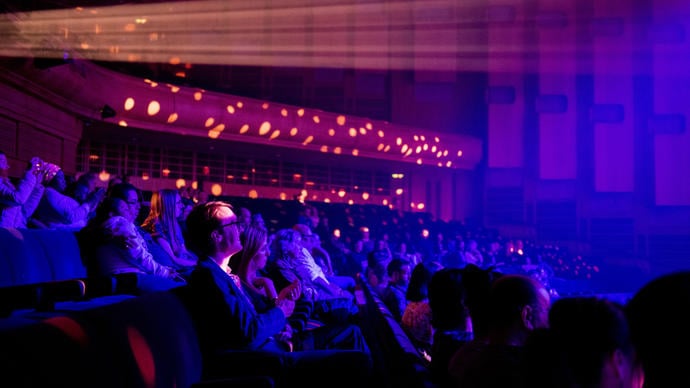For much of her life, St Hildegard of Bingen (1098–1179) experienced highly intense visions which she called ‘the living light’ (lux vivens). What she saw, felt and came to understand through these visions is recorded in her music and the stunning illuminations for Scivias (‘Know the Way’, 1141–51). Some scholars believe that her visions were brought about by migraines and it is this aspect of her life – ‘the living light’ – that is explored tonight.
‘When I was 42 years and seven months old, Heaven was opened and a fiery light of exceeding brilliance came and permeated my whole brain, and inflamed my whole heart and my whole breast.’ Hildegard wrote in Scivias
Hildegard joined the monastery in Disibodenberg (in Germany’s Rhineland-Palatinate) when she was just eight and would stay there for nearly 40 years, eventually becoming abbess in 1136. She founded her own abbey at Rupertsberg near Bingen in 1147 and a second monastery in nearby Eibingen in 1165. Throughout her life, Hildegard was a great spiritual leader, theologian, mystic, scientist and composer. Revered as a saint for centuries, Pope Benedict XVI canonised Hildegard on 10 May 2012.
Laura Moody’s research for the show brought her to The Personal Correspondence of Hildegard of Bingen, translated by Joseph L Baird and Radd K Ehrman. She has set extracts and fragments of Hildegard’s letters in her composition Hildegard Portraits (2021), written especially for this programme. As Laura Moody writes:
‘It is some kind of miracle to have the kind of access to a female creator of the 12th century that we have with Hildegard, her output only having been permissible during her lifetime because of her sacred status. From my perspective this project is also a collaboration with Hildegard herself – not only with her luminous, visionary musical language and multifaceted perspective on life and spirituality, but with her 81 years as a living human being.’
You will hear Moody’s music interspersed throughout the programme in the form of miniatures, culminating in the finale, The Living Light:
‘The libretto for this collects words that Hildegard used to describe the presence she encountered in her visions. The neurologist Oliver Sacks famously hypothesised that Hildegard’s visions were a symptom of migraine with aura and (as a fellow migraineur) I have tried to capture some of that relentlessness and pressure in this virtuosic and rhythmic depiction of her experiences of transcendence.’
The members of Voice were introduced to Hildegard’s music in their teens, performing and recording with Stevie Wishart’s group Sinfonye. The trio are still close to Wishart today and perform from her transcriptions of Hildegard’s manuscripts. Hildegard Transfigured includes two contemporary compositions by Wishart: O Choruscans Lux Stellarum which was written for Voice and is based on a cantus firmus by Hildegard; and Azeruz which sets words from her ‘lingua ignota’ or made-up language.
The other contemporary works in tonight’s programme were all written for Voice and are inspired by Hildegard. Marcus Davidson, friend and long-time composer for the trio, wrote O Boundless Ecclesia as a response to Hildegard’s O orzchis ecclesia. Emily Levy’s composition, How Sweetly You Burn sets text taken from Hildegard’s morality play, Ordo Virtutum (‘Play of Virtues’) – speech and chorus - which is believed by some scholars to have been written as a memorial to Richardis von Stade, close friend and member of Hildegard’s order, following her untimely death. Tim Lea Young composed Three Wings: Part 1 having won a competition run by Brighton Early Music Festival to write for Voice in the early stages of the Hildegard Transfigured project. The ‘three wings’ referenced in his piece is inspired by text from Hildegard’s O virtus sapientie.
All of Hildegard’s works performed this evening come from her body of work Symphonie armonie celestium revelationum (‘The Symphony of the Harmony of the Celestial Revelations’, 1140s–1150s). The trio has chosen them for the beauty of the texts and the uplifting, atmospheric nature of the music.
‘What draws us to her music time and again are the soaring, melismatic lines, the flourishes and ornamentation and especially for the ensemble sound we can create.’ Hildegard’s music has helped to forge Voice’s unique ensemble sound, formed the backbone of many programmes, and provided inspiration for many of the works they have commissioned.



